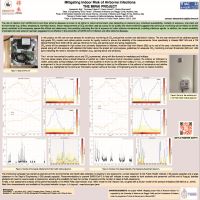Abstract
The risk of infection from SARS-CoV-2 and other airborne diseases is known to be higher in indoor environment, also depending on personal (e.g. individual susceptibility, modality of exposure, viral load) and environmental (e.g. airflow, temperature, humidity) factors. Indoor measurements of CO2 are often used as a proxy for air quality and recent evidence suggests that continuous monitoring can be helpful to identify poorly ventilated multi-occupancy spaces like offices and classrooms, thus possibly evaluating the risk of exposure to indoor airborne contaminants, including infectious agents. In addition, the recent availability of portable low-cost sensors has been suggested to be effective in the prevention of SARS-CoV-2 infection and other airborne diseases.
In this project, we will use low-cost sensors for continuous monitoring of CO2 and particle number size distribution indoors. The low-cost sensors will be calibrate against high-grade CO2 monitor and optical particle counter for quality control to ensure the reliability of the measurements. More specifically a Vaisala GMP 343 and a TSI Optical Particle Sizer 3330 will be used as reference for CO2 and particle count and sizing respectively.
CO2 levels will be assessed in high school and university classrooms in Modena, Northern Italy from March 2022 up to end of the year. Information factsheets will be placed along with the sensors with detailed information about the project aim and purpose, guidelines for adequate CO2 monitoring and alert thresholds (800 and 1400 ppm) indicating the need to increase the ventilation (e.g. opening doors and windows).
The monitoring campaign has started as planned and the environmental and health data collection is ongoing. Considering the recommendations to prevent SARS-CoV-2 in Italy still indicate to wear masks for both students and personnel as well as the lowering of pandemic spread, no positive cases have been identified within the monitored classrooms.
Finally, a risk assessment analysis will be performed based on the Wells-Riley (Gammaitoni et al, 1997) model for the infection risk, coupled with a dilution model of the aerosol emissions (Seinfeld et al., 2016).
This study is supported by the project ‘MIRAI’ (CUP E95F21002900007) funded by the University of Modena and Reggio Emilia and by Fondazione di Modena under the programme “Fondo di Ateneo per la Ricerca 2021”.

